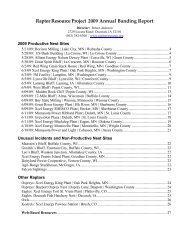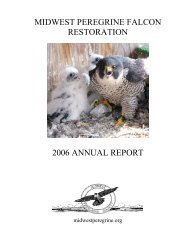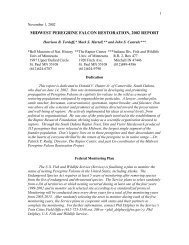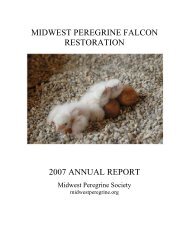1993 - Midwest Peregrine Falcon Restoration Project
1993 - Midwest Peregrine Falcon Restoration Project
1993 - Midwest Peregrine Falcon Restoration Project
Create successful ePaper yourself
Turn your PDF publications into a flip-book with our unique Google optimized e-Paper software.
ural countryside untenable for peregrines, but cities provide good winter<br />
habitat with buildings to live on and pigeons to eat. Across the heart of the<br />
corn belt south of the Great Lakes, peregrines probably do not need to migrate.<br />
<strong>Peregrine</strong>s that do migrate and return in April will find nesting well underway<br />
by falcons that overwintered or returned early. Territorial strife from this<br />
cause seems inevitable until natural selection sorts out a new population with<br />
reasonably synchronized migratory behavior.<br />
The bad weather reduced production of young compared with 1992 (2.6 young<br />
per successful pair in <strong>1993</strong> versus 3.0 in 1992). The number of territorial<br />
pairs increased from 37 to 53, and the total number of young fledged from 68 to<br />
87 (from 54 to 76 if fostered young are excluded). The most satisfying news of<br />
the year came from our neighbors on the Ontario North Shore of Lake Superior.<br />
Surveys by boat and helicopter by the Thunder Bay Field Naturalists and Ontario<br />
Ministry of Natural Resources (Northwest Region) located five pairs (pairs 30 to<br />
34) of peregrines nesting on cliffs, according to Harold Kish (TBFN) and Ted<br />
Armstrong (OMNR). Given the wild country and the large number of splendid<br />
cliffs, the actual number of pairs may easily be twice those counted. Limited<br />
manpower and money made it impossible to identify the adults or to band the<br />
young, but clearly the releases over the past seven years of 50 falcons around<br />
Thunder Bay and Nipigon and 50 on Isle Royale have paid off richly. For those<br />
who relish peregrines on cliffs in wild places, this news from the north is<br />
especially welcome. It takes nothing away from our admiration of the urban<br />
pairs of this adaptable species to have special feelings for peregrines in their<br />
primeval habitat.<br />
<strong>1993</strong> POPULATION STATUS<br />
SUCCESSFUL BREEDING PAIRS<br />
(Pairs fledging young)<br />
1. Multifoods Tower, Minneapolis, Minnesota. Adult peregrines were again<br />
present in Minneapolis through the winter. MF-1 (Muffin) was identified at the<br />
nest box on January 18, her seventh season here. Will 04Y was identified at the<br />
box on March 1, starting his fifth season. Despite her early presence, MF-1<br />
laid late and in a peculiar pattern. She laid two eggs on April 15 and 17,<br />
about ten days later than usual, then laid a third on April 25. The first two<br />
hatched on May 23-24. Bob Anderson then hatched the third in an incubator on<br />
May 26. All three young fledged with no problems, the two older males about a<br />
week before the female. This year we let the young fledge from the nest box,<br />
now modified with a front porch, rather than moving them to the roof as in past<br />
years.<br />
The Multifoods female young, Autumn 5/4, was identified by Pat Skewes in<br />
Madison WI on October 11 and was killed in a collision with a plane at O'Hare<br />
airport in Chicago on October 25.<br />
2. North Central Life Tower, St. Paul, Minnesota. Meg 12R again spent<br />
the winter here and nested for the sixth year. Her mate was apparently Spanky<br />
04T, as in 1992, but his identification was based only on plumage details from<br />
sketches made while he was at the Control Data site in 1989-91; we were unable<br />
to read his black band. He was present on March 3 and probably earlier. Meg<br />
laid four eggs by April 10; three hatched and the two young males and a female<br />
fledged in June. One of the males was found dead on the street near the nest on<br />
June 22.








